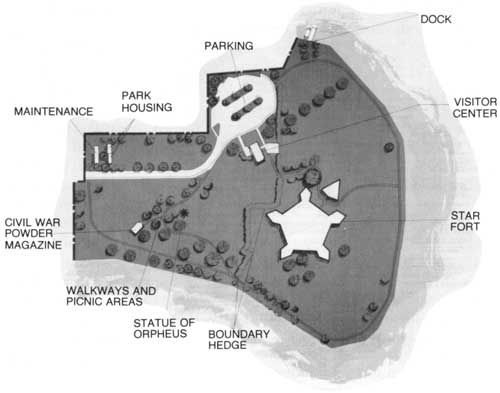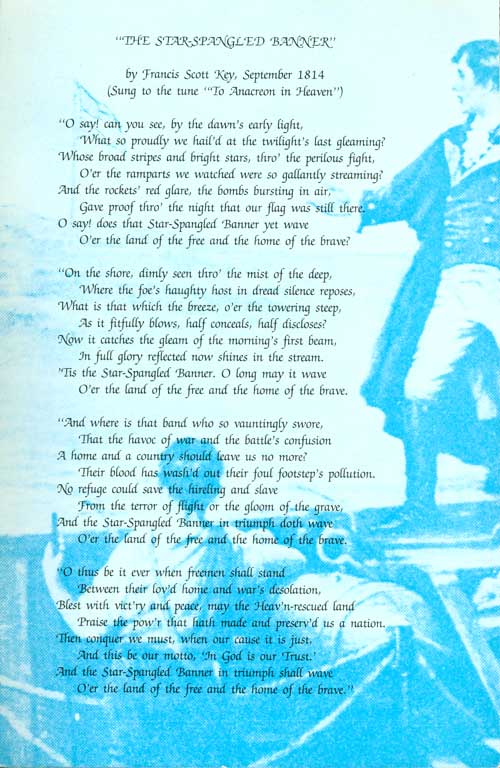|
Our Flag
H. Doc. 100—247 |

|
FORT McHENRY
Fort McHenry is located in Baltimore, Maryland. This low citadel overlooks the entrance to Baltimore harbor and it is where the Americans defended the city against British land and naval attack on September 13-14 in 1814. It was during this battle that Francis Scott Key began the draft to "The Star-Spangled Banner" after seeing the flag still flying after a day and night of bombardment.
The fort continued in active military service for nearly a century after the battle but changing technology eventually made it obsolete as a coastal defense system. Today the 43-acre fort is preserved as a national monument and historic shrine. The property is managed by the National Park Service and the flag is flown over the fort 24 hours a day.

FORT McHENRY NATIONAL MONUMENT AND HISTORICAL SHRINE
THE FLAG HOUSE
The Flag House is located on the northwest corner of Albemarle and Pratt Streets in Baltimore, Maryland. It was the home of Mary Pickersgill from 1807 to 1857, and it was where she made the original "Star-Spangled Banner," which measured 30 by 42 feet. The stripes were two feet wide and the stars were two feet from point to point. Mrs. Pickersgill was paid $405.90 for her services. The flag was delivered to Fort McHenry on August 19, 1813, a full year before the Battle of Baltimore.
In 1876, Caroline Pickersgill Purdy wrote a letter to Georgiana Armistead Appleton, daughter of the Fort McHenry Commandant, in which she recounted the details of the making of the flag. Caroline wrote:
"It was made by my mother, Mrs. Mary Pickersgill, and I assisted her. My grandmother, Rebecca Young, made the first flag of the Revolution under General Washington's directions, and for this reason my mother was selected by Commodore Barney and General Stricker to make this star-spangled banner, being an exceedingly patriotic woman. This flag, I think, contained four hundred yards of bunting, and my mother worked many nights until twelve o'clock to complete it in a given time."
The flag bears the autograph of Lt. Col. George Armistead as well as the date of the British bombardment. The flag remained in the Armistead family for many years until it was loaned to the Smithsonian for an official display in 1907. On December 19, 1912, it was donated to the Smithsonian where it is now on permanent exhibit. In 1914, much-needed preservative work was done on the flag by Mrs. Amelia Fowler and several other restoration experts. Although the flag was reduced in size in order to repair it, the reinforcement technique used has preserved its existence.
The Flag House is a National Historic Landmark, and is operated by an independent non-profit association. The flag is flown over the house 24 hours a day.

"THE STAR-SPANGLED BANNER""
by Francis Scott Key, September 1814
(Sung to the tune"To Anacreon in Heaven")"Oh, say! can you see, by the dawn's early light,
What so proudly we hail'd at the twilight's last gleaming?
Whose broad stripes and bright stars, thro' the perilous fight,
O'er the ramparts we watched, were so gallantly streaming?
And the rockets' red glare, the bombs bursting in air,
Gave proof thro' the night that our flag was still there.
O say! does that Star-Spangled Banner yet wave
O'er the land of the free and the home of the brave?"On the shore, dimly seen thro' the mists of the deep,
Where the foe's haughty host in dread silence reposes,
What is that which the breeze, o'er the towering steep,
As it fitfully blows, half conceals, half discloses?
Now it catches the gleam of the morning's first beam,
In full glory reflected, now shines on the stream.
'Tis the Star-Spangled Banner. O long may it wave
O'er the land of the free and the home of the brave."And where is that band who so vauntingly swore,
That the havoc of war and the battle's confusion
A home and a country should leave us no more?
Their blood has wash'd out their foul footsteps' pollution.
No refuge could save the hireling and slave
From the terror of flight or the gloom of the grave,
And the Star-Spangled Banner in triumph doth wave
O'er the land of the free and the home of the brave."O thus be it ever when freemen shall stand
Between their lov'd home and the war's desolation,
Blest with vict'ry and peace, may the Heav'n-rescued land
Praise the pow'r that hath made and preserv'd us a nation.
Then conquer we must, when our cause it is just,
And this be our motto, 'In God is our trust.'
And the Star-Spangled Banner in triumph shall wave
O'er the land of the free and the home of the brave."
| <<< Previous | <<< Contents>>> | Next >>> |
h_doc_100-247/sec12.htm
Last Updated: 16-Feb-2010